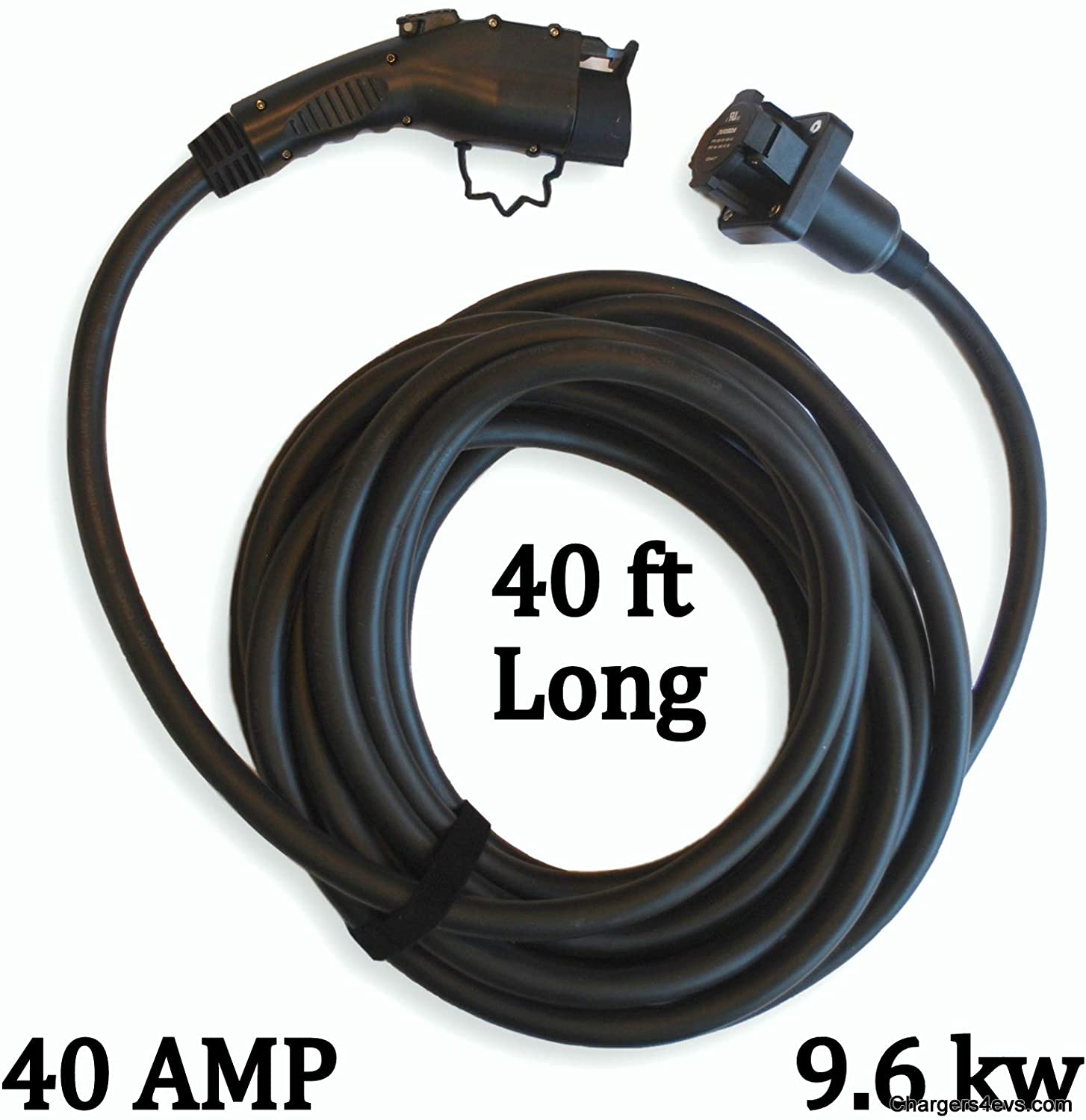Last Update: September 3, 2015

Electricity is 100% clean of any pollutants at the point of use, meaning that electric cars have no tailpipe and emit 0 grams of carbon and 0 grams of any other sort of pollutant. At the tailpipe.
Many buy electric cars for this fact, choosing to pay the electric car price premium as an investment in a clean future for us all. But if electric cars are secretly coal fired dirty monstrosities, aren't we fooling ourselves? Why would environmentally conscious people driving electric cars want more coal to be burned? We don't. Burning coal kinda negates the whole purpose of getting the electric car, doesn't it?
As a tactic in spreading public memes, this works in the subconscious to make one stop, throw up their hands, and give up on driving an electric car. If they don't really help, then why bother switching, right? Some even believe that electric cars are environmentally worse than gasoline cars.
Repeatedly studies have shown even if the electricity comes from coal, electric cars are cleaner than gasoline
Despite the naysayer claims, a proper accounting of emissions footprint shows that, in the U.S. and many countries, electric cars, even running on coal powered electricity, are cleaner than gasoline compatriots. Some studies looking at countries like China or India, with their heavy reliance on coal and weak environmental protections, found that electric cars running on their electricity is dirtier, and therefore claimed all electric cars are dirtier than gasoline.
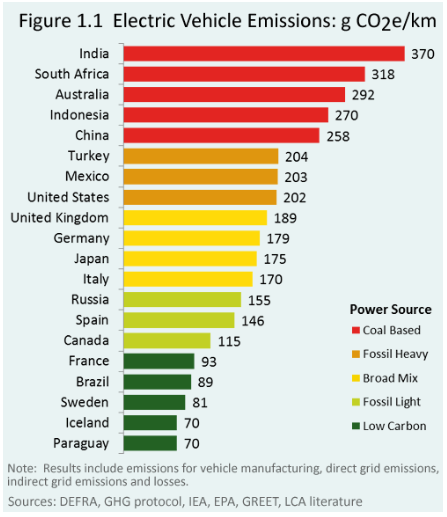
This image comes from a study published at
shrinkthatfootprint.com going over two questions:
- are electric cars cleaner than gasoline cars,
- is that true even when accounting for the manufacturing environmental impact.
What's shown are electric vehicle emissions, including manufacturing impact, in various countries. The difference between these countries comes from the predominant source of electricity. In some countries it's predominantly coal, whereas in other countries it isn't. Iceland has a lot of geothermal electricity sources thanks to all the volcanic activity, and Paraguay has a lot of hydroelectric sources thanks to the mountains.
By the way, another criticism of electric cars is the higher manufacturing intensity to build them. Electric cars contain more material than gasoline cars, and therefore requires more resources (minerals and energy) to build. Therefore, the environmental impact to build them is higher. The ShrinkThatFootprint paper goes over that question, and finds that the environmental savings from not burning gasoline more than make up for this increased impact.
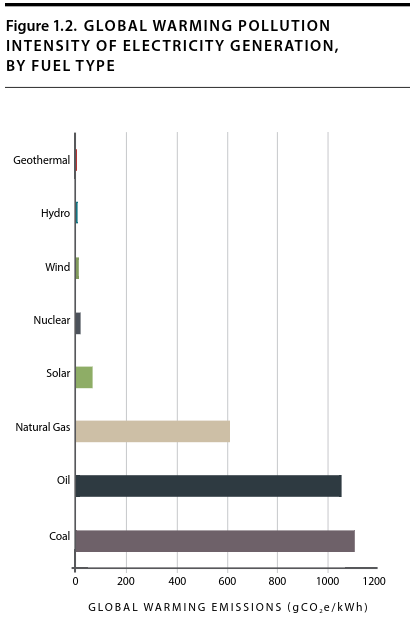
Maybe you've never heard of
shrinkthatfootprint.com and don't know whether to trust their report. You probably have heard of the Union of Concerned Scientists, and know that they're a trustworthy source. In 2012 UCS published a report "State of Charge: Electric Vehicles’ Global Warming Emissions and Fuel Cost Savings Across the United States" comparing not only climate change emissions footprint of electric and gasoline cars, but also the cost factors.
This chart shows the relative greenhouse emissions intensity of different electricity sources. We've already gone over this idea, but this makes it clear how much of an improvement solar or wind power is over even natural gas to generate electricity.
Natural gas is positioned as a wonder-fuel that will solve for climate change. But compared to solar power...?
A caption in the report under this image tells us:
Notes: Estimates are based on electricity delivered to consumers and include the full life-cycle emissions, including those accruing from plant construction and maintenance, fuel production (e.g., coal mining), transportation, fuel combustion, and electricity transmission. Variations in global warming emissions intensity occur within fuel types. These values represent the average emissions intensity across all plants of a given fuel type.
Applying the climate change impact of each electrical source type across the electricity mix of each region in the U.S. the UCS scientists derive this chart:
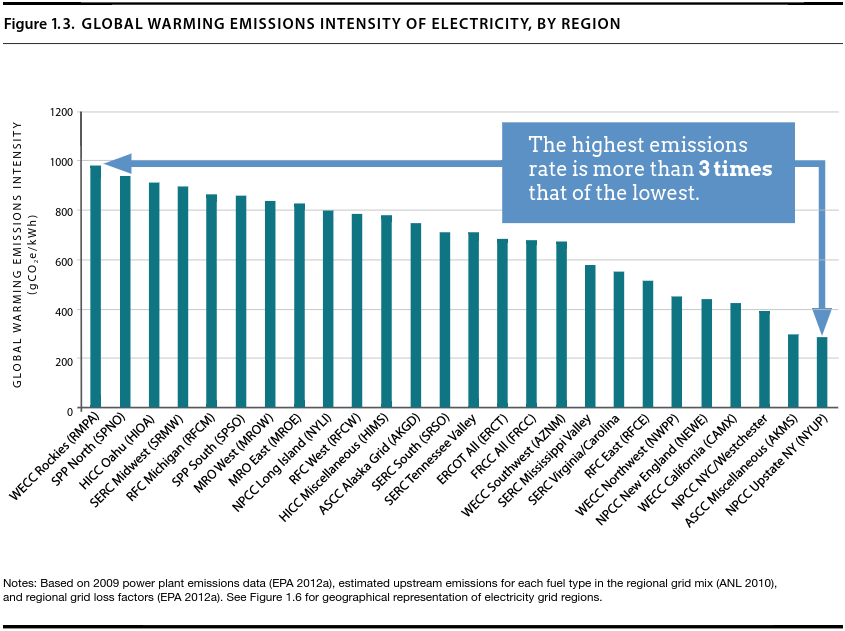
Some regions are more heavily invested in coal than other regions.

Next piece of data from the UCS report is a rating called MPGghg. It's an attempt to compare the miles-per-gallon-greenhouse-gas equivalence between gasoline and electric cars.
In gasoline powered cars the principle is that higher fuel efficiency means less gasoline burned per mile, for a lower greenhouse gas impact. The 40 miles/gallon fuel sipper is a lot cleaner than the 18 miles/gallon gas hog, in other words. But electric vehicles don't measure their fuel in gallons, so how can we compare their greenhouse gas impact?
This MPGghg figure states how many miles per gallon a gasoline-powered vehicle would need to achieve in order to match the global warming emissions of an EV.
In other words, when the EV is powered off a hydro-electric source, the gasoline car has to achieve a 5,800 MPG to have an equivalent greenhouse gas impact.
The first step of calculating MPGghg is to evaluate the greenhouse gas impact of charging an electric vehicle off each source of electricity. You can then compare that impact to the impact of a gasoline powered vehicle, and through some mathematical formulas come up with MPGghg.
Now let's apply the MPGghg figures across the U.S. electrical grid.
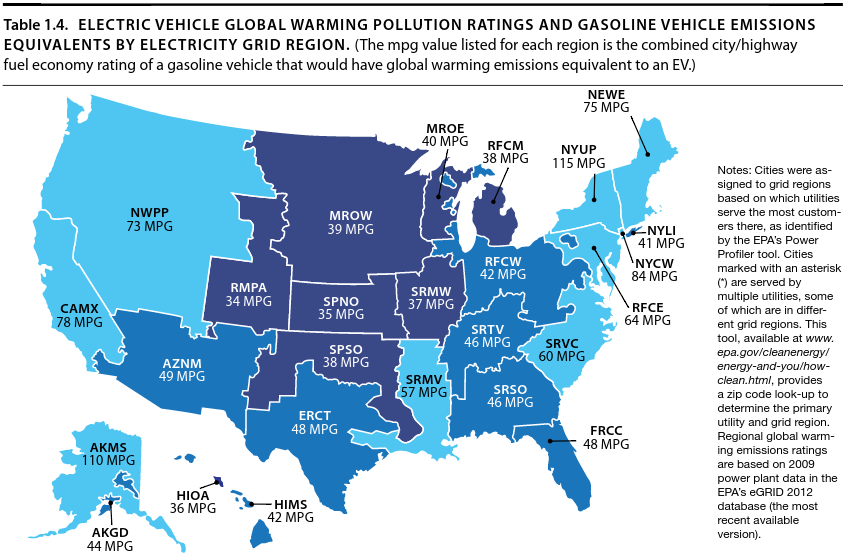
As shown in one of the earlier charts, the cleanliness of the U.S. electrical grid varies from region to region. Some places have hydro-electric resources, others prefer natural gas, others prefer coal, and some areas even use oil to generate electricity.
But we see that even in the worst area of the country, Rocky Mountain Power (Colorado and parts of Wyoming), the gasoline powered car has to get 34 MPG to equal the cleanliness of an electric car. Since that's better than the average fuel economy of gasoline vehicles, that means the electric car is still better even off the dirtiest electricity in the U.S.
The caption refers to a tool at
http://www.epa.gov/cleanenergy/energy-and-you/how-clean.html which lets you explore the greenhouse impact of the electricity service in your area.
Not all electricity is from Coal
We see this in the charts above, but it's worth reiterating. While coal generates 50% of the electricity in the U.S., it's unevenly spread. Some areas are more reliant on coal than others. In California, where I live, the majority of electricity comes from Natural Gas.
Wind & Solar power is getting less expensive all the time
Wind and solar power are hugely preferable over even natural gas, as shown by the charts above. What stops wind and solar is the cost of the systems, and that they're an intermittent electricity source. Intermittency means that the wind isn't always blowing, and the sun isn't always shining, meaning that wind and solar isn't completely suitable for base-load electricity needs that we require to have a 99.99999% reliable electricity grid.
The intermittency problem is solvable with some kind of grid energy storage system. And, in fact, that's a role they want electric cars to play. A parking lot full of electric cars makes for a pretty big electrical storage system, if all the cars are connected to the grid.
Solar power is on a development curve to be directly price-competitive within a few years. In the meantime more and more clean renewable electricity options are becoming available.
Bloomberg News reported on a Deutsche Bank report in October 2014 saying that by 2016 solar power systems will be as cheap or cheaper than grid electricity in 47 U.S. States. That means solar power systems mounted on a home are no longer just a plaything of the ecologically minded rich person. It will soon make more economic sense to mount solar power array on ones home, than to buy electricity from the utility. On the Australian website, RenewEconomy, referring to the same report, they say that solar power systems will be at or better than grid parity cost around the world by 2017. A
grist.org article came to a similar conclusion back in 2013.
And if that's the case for retail solar power installations, it must be doubly true for industrial scale commercial solar power installations.
What this means is that in a very short time solar power systems won't require government incentives, they'll just be cheaper and they'll be the preferred solution. As we saw above, solar power is so much cleaner than fossil fuel power that we could see a rapid transformation of the greenhouse gas impact of our society.
You can make your own electricity on your own rooftop
Gasoline vehicle owners can't make their own fuel. The closest would be growing a corn field out back and brewing ethanol, but that's a labor-intensive and space-intensive project.
On the other hand, most homes have rooftop space large enough to hold enough solar panels to power not only the home, but electric cars owned by the family. Of course whether that works out in a given situation depends on several factors, such as the orientation of the roof, and nearby trees or large buildings blocking the sunlight. Most factories or warehouses or office parks or parking lots have enough space for enough solar panels to power the facility.
But, wait, that's not all

This van is owned by Lightning Motorcycle, maker of the fastest electric motorcycle in production in the world. This normal Daimler Sprinter Van, was modified by Lightning's team to be a standalone race support vehicle. The solar array is large enough to provide way more than enough power for a weekend of racing two bikes, plus running power tools and food-cooking-machinery. Inside the van is a large lithium-ion battery pack with 12 kilowatts of inverters, so they can fast-charge a motorcycle.
When Lightning's team went to the Pikes Peak International Hill Climb in 2013, which they won, they spent about a month on the mountain testing two bikes. The bikes were powered with this very setup. The rider would take one bike up the mountain while the other was charging. On his return he'd switch bikes taking the fully charged one up the mountain while the first bike was being charged. He was kept busy riding, the bikes stayed fully charged, and no fossil fuels were used other than what the van used driving to their base camp. A gasoline powered superbike team would have spent thousands of dollars on fuel during such testing.
In other words, in the footprint of a normal Sprinter van there's enough electricity generating capacity to power a high end electric motorcycle through a weekend of racing.
The grid gets cleaner as time progresses, while gasoline cars get dirtier as time progresses
That old clunker burns gasoline less cleanly than it did when new. As engines age they inevitably begin to irreparably fall apart, become less efficient, and just plain become dirtier.
Over time, electricity on the grid gets cleaner and cleaner. That's because of ever-tighter regulations requiring cleanup measures, and as old inefficient power plants are retired they're replaced with new efficient ones.
How far can you drive on the Kilowatt-hours used to refine a gallon of gasoline
It costs power to refine gasoline. I've seen figures claiming 3 kilowatt-hours, 4 kilowatt-hours, or even 6 kilowatt-hours to refine each gallon of gasoline (see The 6 kWh electricity to refine gasoline would drive an electric car the same distance as a gasser?). How far will an electric car drive on the electricity required to refine a gallon of gasoline? How far will a gasoline car drive on that gasoline?
A gallon of gasoline could take a gas-powered car 30 miles or so depending on the car's efficiency.
An electric car uses 340 watt-hours per mile (or so). Meaning:
3 kwh = 8.8 mi, 4 kwh = 11.76 mi, 6 kwh = 17.65 mi
In other words, if the electricity used to refine the gasoline were instead used to power a car, the car would go nearly as far.
Summary
The hand-waving argument - electric cars are dirty because the grid is coal powered - just doesn't fly when faced with reality.
But what's most important is to recognize the necessity of cleaning up the electricity grid, and shifting power plants away from fossil fuels. The difference in environmental impact between even the supposedly clean natural gas and solar electricity is immense.
The good news is that soon enough it will become economically viable to select solar power systems. At that point the electrical utilities will surely increase their investments in solar and even wind systems, because it will simply be the best business decision to do so.
